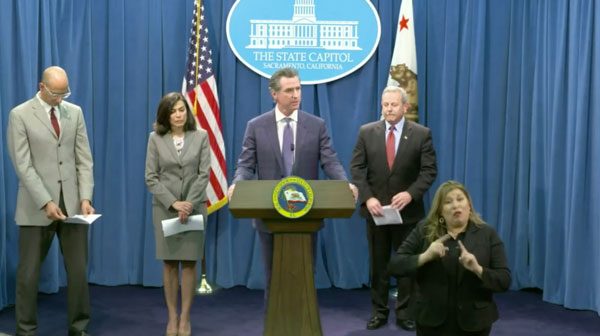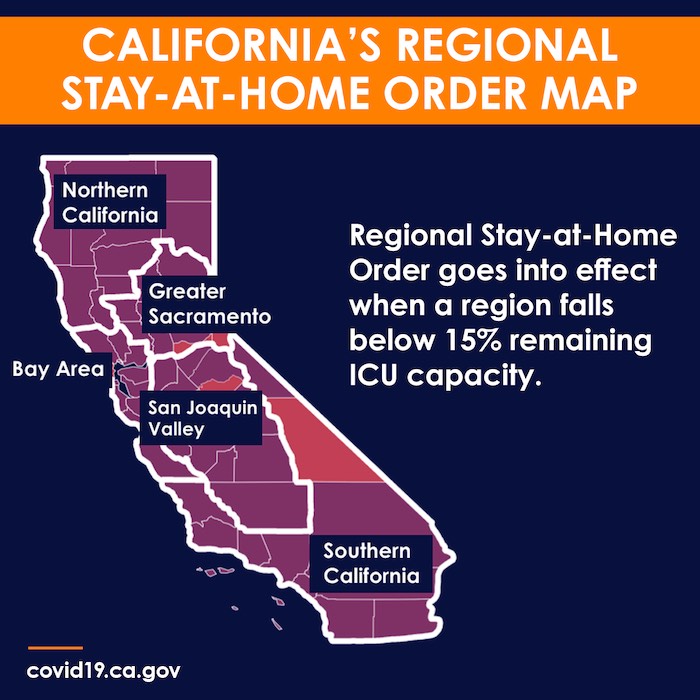State announces strict ‘Regional Stay at Home Order’ triggered by ICU capacity

California Gov. Gavin Newsom at a recent press conference.
Update posted Dec. 4:
State order could impact SLO County as soon as Sunday
–The State of California has issued a Regional Stay at Home Order requiring Californians to stay at home as much as possible to help stop the surge of COVID-19 and prevent overwhelming regional intensive care unit (ICU) capacity. This order means SLO County businesses should prepare for additional restrictions and closures from the tate as soon as this weekend.
The order focuses on slowing the spread by region. SLO County is in the Southern California region, which is projected to reach the state’s ICU capacity limit by Friday, Dec. 4. The order will go into effect within 48 hours in regions with less than 15-percent ICU availability. After that, the state may lift the order when a region’s ICU usage drops below 85-percent of its capacity.
“We’re disappointed to be included in the Southern California region for this Stay at Home Order because SLO County is relatively healthy and our hospital and ICU bed usage remains low,” said Dr. Penny Borenstein, County Health Officer. “Sheltering at Home is a tremendous sacrifice.”
When in effect, the order will result in closures of various sectors, including indoor and outdoor playgrounds; hair salons and personal care services; wineries, bars, breweries and distilleries, and more. However, certain sectors can remain open with modifications, including outdoor recreational facilities, retailers (20-percent capacity limit), restaurants (take-out, pick-up or delivery only), hotels (for critical infrastructure support), and others.
Critical infrastructure sectors, schools that are already open for in-person learning, childcare, and pre-K, and medical and dental care may remain open. The order allows access to critical services and allows outdoor activities for physical and mental health.
“Now is the time to rally around and take care of our local businesses and neighbors,” said Dr. Borenstein. “If you can, shop from local retailers online from the safety of your home, order takeout from local restaurants and eateries, and support local nonprofits. If you are struggling, help is available. Visit ReadySLO.org for local and state resources to help you get through this time.”
For more information, visit ReadySLO.org or call the recorded Public Health Information Line at (805) 788-2903. A staffed phone assistance center at (805) 543-2444 is available Monday – Friday, from 8 a.m. to 5 p.m. to assist with questions related to COVID-19.
“We’re disappointed to be included in the Southern California region,” said Dr. Borenstein. “Yet SLO County has proven that we are resilient – we will get through this by taking care of each other, keeping ICU bed usage low, and preparing for a vaccine.” https://t.co/hmh7UhSoqX
— SLO Public Health (@SLOPublicHealth) December 4, 2020
Original story posted Dec. 3:
State health officials announce new ‘Regional Stay at Home Order’ triggered by ICU capacity
–As COVID-19 case rates and hospitalizations continue to rise at an alarming pace and threaten to overwhelm the health care delivery system, California health officials today announced a Regional Stay at Home Order that will be triggered if Intensive Care Unit (ICU) capacity drops below 15-percent in a given region. State health officials are tracking the state by five regions: Northern California, Bay Area, Greater Sacramento, San Joaquin Valley, and Southern California. No regions currently meet this threshold but some are projected to as early as this week. When the order is triggered in a region, it will have 48 hours to adopt the new order. Residents are required to stay at home as much as possible and minimize mixing to reduce unnecessary exposure, while still being able to do important things like go to the doctor, buy groceries, pick up take out, go on a hike, or worship outdoors. K-12 schools that are already open can remain open and retailers can operate indoors at no more than 20-percent capacity to reduce exposure risk.
The five regions are:
· Northern California: Del Norte, Glenn, Humboldt, Lake, Lassen, Mendocino, Modoc, Shasta, Siskiyou, Tehama, Trinity
· Bay Area: Alameda, Contra Costa, Marin, Monterey, Napa, San Francisco, San Mateo, Santa Clara, Santa Cruz, Solano, Sonoma
· Greater Sacramento: Alpine, Amador, Butte, Colusa, El Dorado, Nevada, Placer, Plumas, Sacramento, Sierra, Sutter, Yolo, Yuba
· San Joaquin Valley: Calaveras, Fresno, Kern, Kings, Madera, Mariposa, Merced, San Benito, San Joaquin, Stanislaus, Tulare, Tuolumne
· Southern California: Imperial, Inyo, Los Angeles, Mono, Orange, Riverside, San Bernardino, San Diego, San Luis Obispo, Santa Barbara, Ventura
Regions will remain in the Regional Stay at Home Order status for at least three weeks once triggered. Counties are eligible to come off the Regional Stay at Home Order after three weeks if their hospital ICU capacity projected four weeks outreaches 15-percent. Counties will return to the Blueprint for a Safer Economy tier determined by their case rate and test positivity after they are eligible to exit the Regional Stay at Home Order.
While the number of COVID-19 ICU patients in San Luis Obispo County is very low, currently one person, and ICU capacity here is good, in Los Angeles County ICU capacity is currently just 24-percent.
“We are at a tipping point in our fight against the virus and we need to take decisive action now to prevent California’s hospital system from being overwhelmed in the coming weeks,” said Governor Newsom. “By invoking a Stay at Home Order for regions where ICU capacity falls below 15-percent, we can flatten the curve as we’ve done before and reduce stress on our health care system. I’m clear-eyed that this is hard on all of us – especially our small businesses who are struggling to get by. That’s why we leaned in to help our small business owners with new grants and tax relief to help us get through this month. If we stay home as much as possible, and wear masks when we have to go to the doctor, shop for groceries, or go for a hike, California can come out of this in a way that saves lives and puts us on a path toward economic recovery.”
“We know what a struggle this pandemic has been for so many California families, but our actions have saved countless lives,” said Dr. Mark Ghaly, California Health, and Human Services Secretary. “This targeted action will preserve vital ICU beds for people who need them – whether they’re COVID-19 patients or someone who has suffered a heart attack or a stroke.”
“Staying home for three weeks is a sacrifice, but if every Californian did that for a month, we could stop this disease in its tracks,” said Dr. Erica Pan, Acting State Public Health Officer. “This public health order strikes the balance between saving lives, providing essential services that we all rely on and still allowing Californians to participate in lower-risk outdoor activities that are crucial for our physical and mental health.”
The terms of the Regional Stay at Home Order closely mirror the March order, with some variations.
What does the Regional Stay at Home Order do?
The Regional Stay at Home Order would be in effect for three weeks after the trigger and instructs Californians to stay at home as much as possible to limit the mixing with other households that can lead to COVID-19 spread. It allows access to (including travel for) critical services and allows outdoor activities to preserve Californians’ physical and mental health. This limited closure will help stop the surge and prevent overwhelming regional ICU capacity.
In any region that triggers a Regional Stay at Home Order because it drops below 15-percent ICU capacity, all operations in the following sectors must be closed:
· Indoor and Outdoor Playgrounds
· Indoor Recreational Facilities
· Hair Salons and Barbershops
· Personal Care Services
· Museums, Zoos, and Aquariums
· Movie Theaters
· Wineries
· Bars, Breweries, and Distilleries
· Family Entertainment Centers
· Cardrooms and Satellite Wagering
· Casinos
· Limited Services
· Live Audience Sports
· Amusement Parks
The following sectors will have additional modifications in addition to 100-percent masking and physical distancing:
· Outdoor Recreational Facilities: Allow outdoor operation only without any food, drink, or alcohol sales. Additionally, overnight stays at campgrounds will not be permitted.
· Retail: Allow indoor operation at 20 percent capacity with entrance metering and no eating or drinking in the stores. Additionally, special hours should be instituted for seniors and others with chronic conditions or compromised immune systems.
· Shopping Centers: Allow indoor operation at 20 percent capacity with entrance metering and no eating or drinking in the stores. Additionally, special hours should be instituted for seniors and others with chronic conditions or compromised immune systems.
· Hotels and Lodging: Allow to open for critical infrastructure support only.
· Restaurants: Allow only for take-out or pick-up.
· Offices: Allow remote only except for critical infrastructure sectors where remote working is not possible.
· Places of Worship: Allow outdoor services only.
· Entertainment Production including Professional Sports: Allow operation without live audiences. Additionally, testing protocol and “bubbles” are highly encouraged.
The following sectors are allowed to remain open when a remote option is not possible with appropriate infectious disease preventative measures including 100 percent masking and physical distancing:
· Critical Infrastructure
· Schools that are already open for in-person learning
· Non-urgent medical and dental care
· Child care and pre-K
When does a Regional Stay at Home Order end?
The Regional Stay at Home Order will be implemented regionally once there is less than 15 percent ICU capacity remaining in the designated region. After three weeks from the start of the Stay-at-Home Order, the following criteria would apply:
1. End for a county in a region if the region’s ICU capacity projected out four weeks (from three weeks since the Stay-at-Home Order started) is above or equal to 15 percent. Each county in the region would be assigned to a tier based on the Blueprint for a Safer Economy.
2. Remain in effect in a county if the region’s ICU capacity projected out four weeks (from three weeks since the Stay-at-Home Order started) is less than 15 percent. The order would remain in effect until the region’s ICU capacity meets criteria (1) above. This would be assessed on a weekly basis.
Can people go outside?
Members of the same household are encouraged to maintain physical and mental health by safely going to a park, a beach, hike, walk, or bike ride when safe to do so and socially distanced. Californians are also encouraged to keep connected with loved ones virtually.
Comments
The news staff of the Paso Robles Daily News wrote or edited this story from local contributors and press releases. The news staff can be reached at info@pasoroblesdailynews.com.























